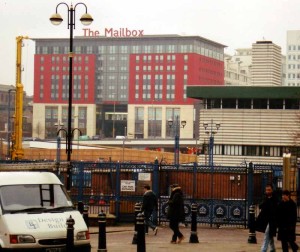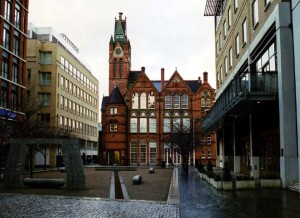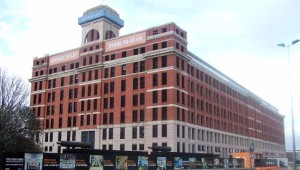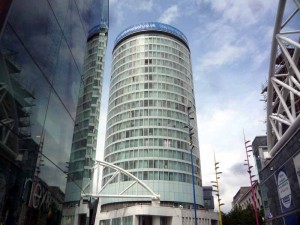By Alan Clawley.
Given an owner who is minded to do so, any sound building can be adapted to a new use.
 The evidence is all around to see. Buildings from the ’60s and ’70s are no exception. Imaginative developers have transformed the once drab Royal Mail Sorting Office into the crimson ‘Mailbox’; apartment-dwellers have replaced the office-workers who once gazed over New Street from the Rotunda. These buildings stood neglected and empty for long periods before someone spotted their potential and rescued them from almost certain death. Their previous owners had no further use for them and disposed of them like last year’s sofa. The same attitude can be found in the City Council, which relies entirely on others to take publicly-owned buildings off its hands and its books when they are ‘surplus to requirements’.
The evidence is all around to see. Buildings from the ’60s and ’70s are no exception. Imaginative developers have transformed the once drab Royal Mail Sorting Office into the crimson ‘Mailbox’; apartment-dwellers have replaced the office-workers who once gazed over New Street from the Rotunda. These buildings stood neglected and empty for long periods before someone spotted their potential and rescued them from almost certain death. Their previous owners had no further use for them and disposed of them like last year’s sofa. The same attitude can be found in the City Council, which relies entirely on others to take publicly-owned buildings off its hands and its books when they are ‘surplus to requirements’.
Disposing of a Listed building is difficult but not impossible. The Grade II Listed Green Lane Baths and Library was sold to a Muslim association in 1977 for £25,000 and it has used them as a mosque and community centre ever since. John Madin’s 1974 Central Library was, however, not listed and can be altered in any way to suit new uses. The faulty concrete cladding panels, the source of much criticism, can be repaired or replaced with new ones, or replaced with glass panels or any other non-structural skin. Passenger lifts can be installed to rise dramatically through the full height of the building inside the atrium.
What can the empty building be used for once the last book has been moved to the new library and the tenants of Paradise Forum have moved out? Just imagine the grand volumes of space both inside and outside that will have been released.
 Friends of the Central Library have their own suggestions but they don’t have a monopoly on ideas. A hotel, department store, or commercial offices, or a mixture of such uses, are the most obvious but somewhat conventional suggestions, but there is a strong feeling that the building should maintain a civic presence here and be dedicated to social and cultural purposes. That is what John Madin argued for and why he was vehemently opposed to the commercial redevelopment of what he called the Civic Heart of the City.
Friends of the Central Library have their own suggestions but they don’t have a monopoly on ideas. A hotel, department store, or commercial offices, or a mixture of such uses, are the most obvious but somewhat conventional suggestions, but there is a strong feeling that the building should maintain a civic presence here and be dedicated to social and cultural purposes. That is what John Madin argued for and why he was vehemently opposed to the commercial redevelopment of what he called the Civic Heart of the City.
One imaginative use for the building is to transform it into a museum or gallery. A ‘Museum of Music’, a ‘Museum of the Twentieth Century’, a ‘Museum of Photography’ and a ‘Tate Birmingham’ have all been suggested. The history of twentieth century culture and technology particularly in the West Midlands is a common theme here and it would be entirely appropriate for one or all of them to be housed in an important example of twentieth century architecture which is itself in danger of being lost forever. And, stored in a warehouse in Nechells is a huge archive of exhibits that could now see the light of day. The Museum could have exhibitions on the history of Birmingham, a history of the arts, music, science, the people of Birmingham, a social history of Birmingham and so on. The grand space under the central atrium could display big modern sculptures and large-scale art installations.
Another proposal emphasises the social and economic use of the building and the idea of a ‘Twenty-First Century Trade Centre’, a base for voluntary organisations, or a suite of workshops and retail outlets for practising artists and craft persons. Museum, tourist attraction, economic catalyst and celebration of heritage could be all under one roof. A training component could be added whereby manufacturing skills are passed on to the next generation. It could combine serious vocational training for students during the day time and classes for “hobbyists” in the evenings and weekends. This idea could attract funding from both worklessness and heritage initiatives.
 There are various management and funding models that can be adopted. It has even been suggested that an application could by made for the building to be transferred as ‘Community Asset’ under the terms of the Localism Act. All that is needed is vision and the determination to turn that vision into reality. .
There are various management and funding models that can be adopted. It has even been suggested that an application could by made for the building to be transferred as ‘Community Asset’ under the terms of the Localism Act. All that is needed is vision and the determination to turn that vision into reality. .
This article was published in the Birmingham Post 26 April 2012
Alan Clawley is Secretary of Friends of the Central Library and author of John Madin, Twentieth Century Architect.



